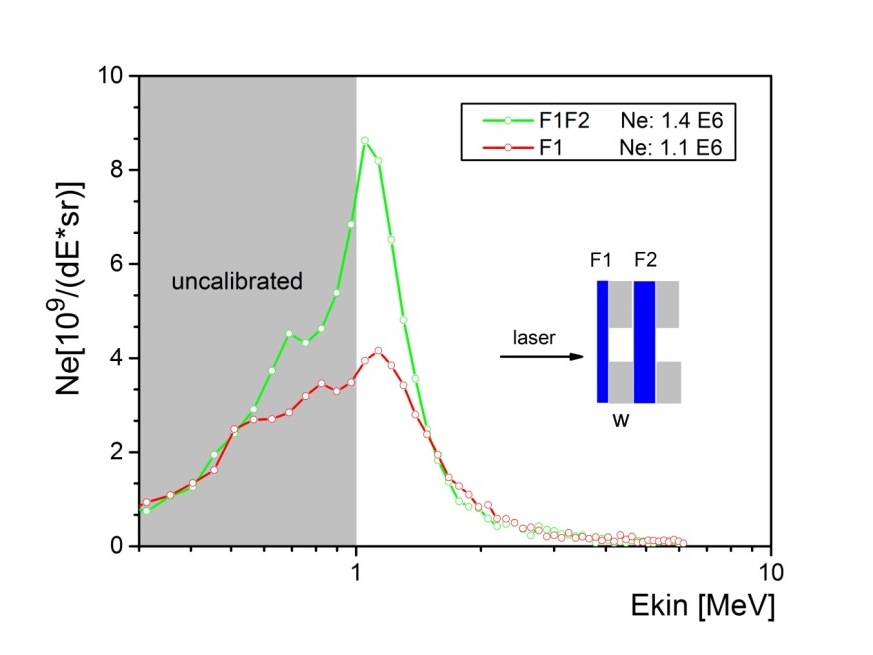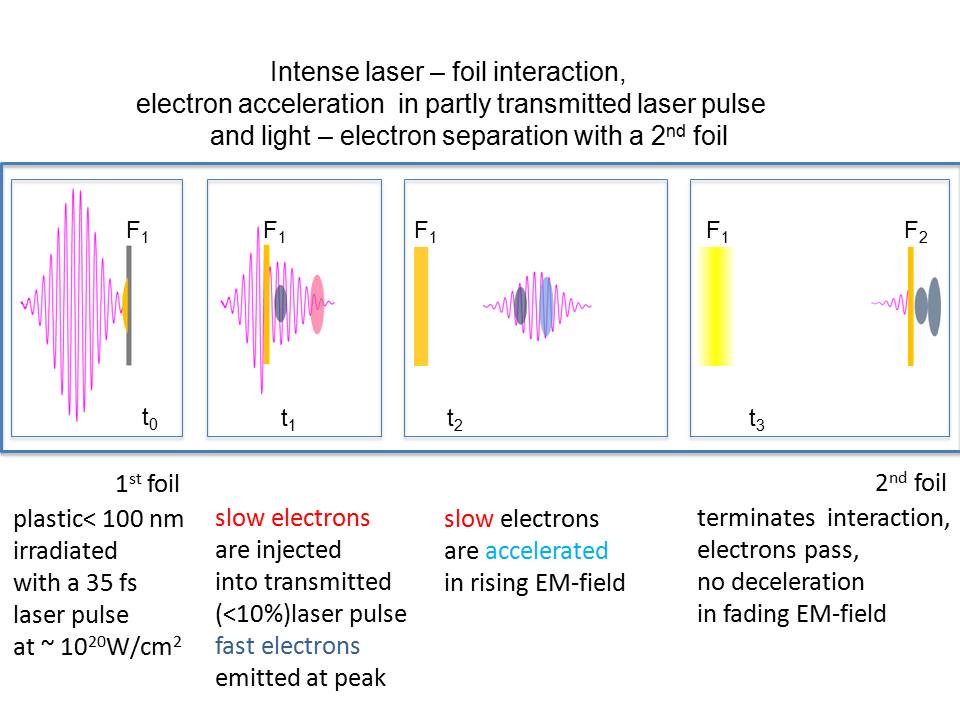10.01.2017
Controlled direct acceleration of electrons in very strong laser fields can offer a path towards ultra-compact accelerators. Such a direct acceleration requires rectification and decoupling of the oscillating electromagnetic laser field from the electrons in a suitable way. Researchers worldwide try to tackle this challenge. In experiments at the Max Born Institute, direct laser acceleration of electrons could now be demonstrated and understood in detail theoretically. This concept is an important step towards the creation of relativistic and ultra-short electron pulses within very short acceleration distances below one millimeter. Resulting compact electron and related x-ray sources have a broad spectrum of applications in spectroscopy, structural analysis, biomedical sciences and for nanotechnology.
The way electrons can be accelerated up to relativistic kinetic energies in strong laser fields is a fundamental issue in the physics of light-matter interaction. Although the electromagnetic fields of a laser pulse force a free electron previously at rest to oscillations with extremely high velocities, these oscillations cease again when the light pulse has passed by. A net energy transfer by such a direct acceleration of a charged particle in the laser field cannot take place. This fundamental principle - often discussed in physics exams - is valid for certain boundary conditions of the spatial extent and intensity of the laser pulse. Only for particular, different boundary conditions, electrons can indeed receive a net energy transfer via acceleration from the strong laser field. These conditions can be set e.g. by focusing of the laser pulse or the presence of strong electrostatic fields in a plasma.
Worldwide, scientists are looking for solutions how fast electrons can be extracted from extremely strong laser fields and how one can obtain short electron pulses with a high charge density via ultra-short laser pulses.
In light fields of relativistic intensity (I> 1018 W/cm2) electrons oscillate with velocities close to the speed of light. The corresponding kinetic energy reaches values from MeV to GeV (at I> 1022 W/cm2. Strong light fields are realized by focusing ultra-short laser pulses with high energy down to areas of few micrometers. The resulting spatial intensity distribution does already enable the acceleration of the electrons up to high kinetic energies. This process is known as ponderomotive acceleration. It is an essential process for the interaction between strong light fields and matter. Various theoretical studies, however, have predicted that the number of electrons and their kinetic energy can be further significantly increased by a direct acceleration in the laser field, but only if the electron-light interaction is interrupted in a properly tailored way. These considerations were the starting point for the experiments by Julia Braenzel and her colleagues at the Max Born Institute.
In the experiments at MBI, the electrons were decoupled from the light pulse at a particular moment in time, using a separator foil that is opaque for the laser light but can transmit fast electrons. We could show that this method leads to an increase of the number of electrons with high velocities. At first, a 70 TW Ti:Sapphire laser pulse (2 J @ 35 fs) irradiates an 30 - 100 nm thin target foil consisting of a PVF-polymer. In the laser propagation direction, about 109electrons are accelerated up to several MeV energy via the ponderomotive force. During this interaction the foil is almost fully ionized and transformed into plasma.

Fig. 1b: Detected electrons in the laser propagation direction from a single (F1) and double foil (F1F2) target configuration, where the soncond foils acts as a speparator. The plastic foils used were about F1=35nm and F2=85 nm thick. N e values represent the integrated electron numbers for the whole detection range (0,2-7,5 MeV) with respect to the spectrometer aperture.
For sufficiently thin target foil thicknesses below 100nm a fraction of the incident laser light can be transmitted through the plasma. The transmitted light starts to overtake the electrons already emitted in this direction. This corresponds to a quasi-intrinsically synchronized injection of slow electrons into the transmitted, but still relativistic laser field (<8 x 1018W/cm2). If a second thin separator foil is placed at the correct distance behind the first one, amplification in the electron signal for a particular energy interval is observed. Fig. 1a) shows a schematic of the temporal evolution in the experiment and Fig. 1b) presents a direct comparison of the detected electron spectral distribution for a single foil and a double foil configuration, where the second foil acts as a separator. This foil is opaque for the laser light but is transparent for the fast electrons and hence enables a decoupling of both. The time at which the interaction between electrons and transmitted light is interrupted depends on the distance between the two foils.
The experiments carried out in the group of Matthias Schnürer demonstrate that an amplification of the electron signal can obtained and is maximized for a particular distance. The amplification vanishes for very big distances. Numerous measurements as well as numeric simulations confirmed the hypothesis that electrons with high kinetic energy can indeed be extracted out of the light field if they are decoupled appropriately. If the separator foils is located at an optimized position, slow electrons with kinetic energies below 100keV are accelerated to about ten times higher kinetic energies. This effect leads to a concentration of electrons in a narrow energy interval. In contrast to experiments using the different mechanism of laser wake field acceleration, where the production of GeV electrons has already been demonstrated, the direct laser acceleration demonstrated here can be scaled up to high laser intensities and high plasma densities. Beyond the fundamental insight in laser-matter interactions, the direct laser acceleration demonstrated in this work holds promise for the future realization of compact sources of relativistic electrons.















